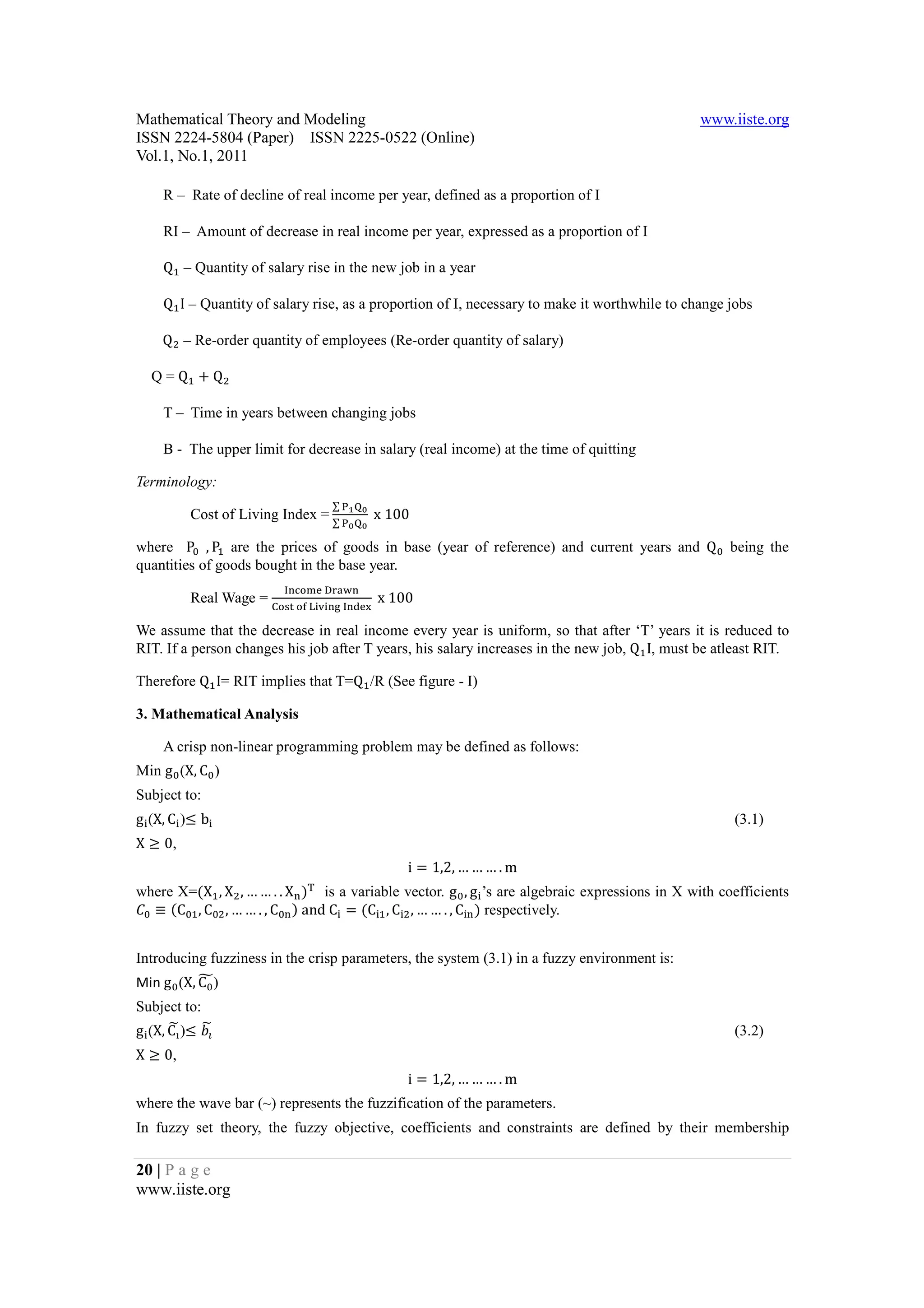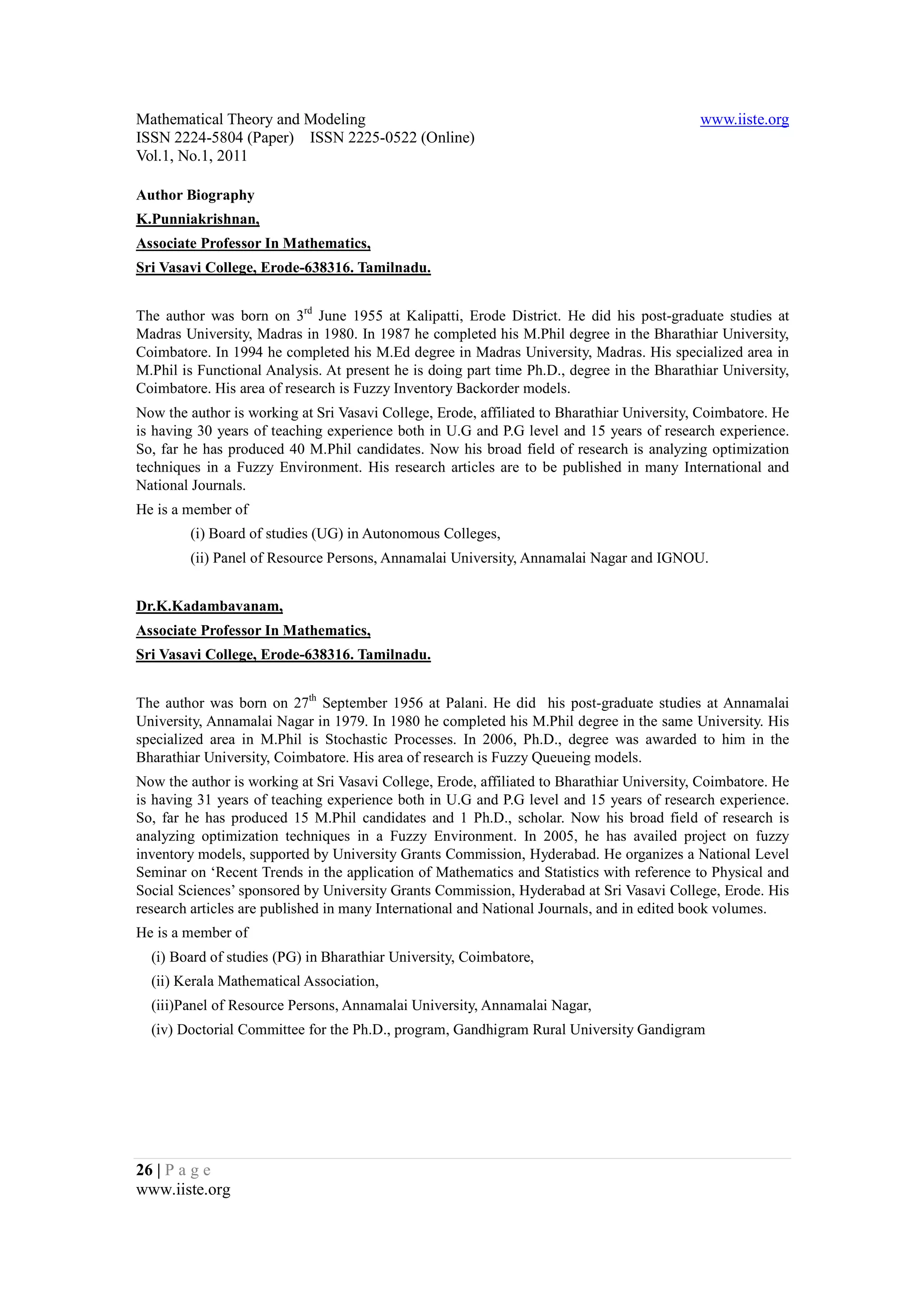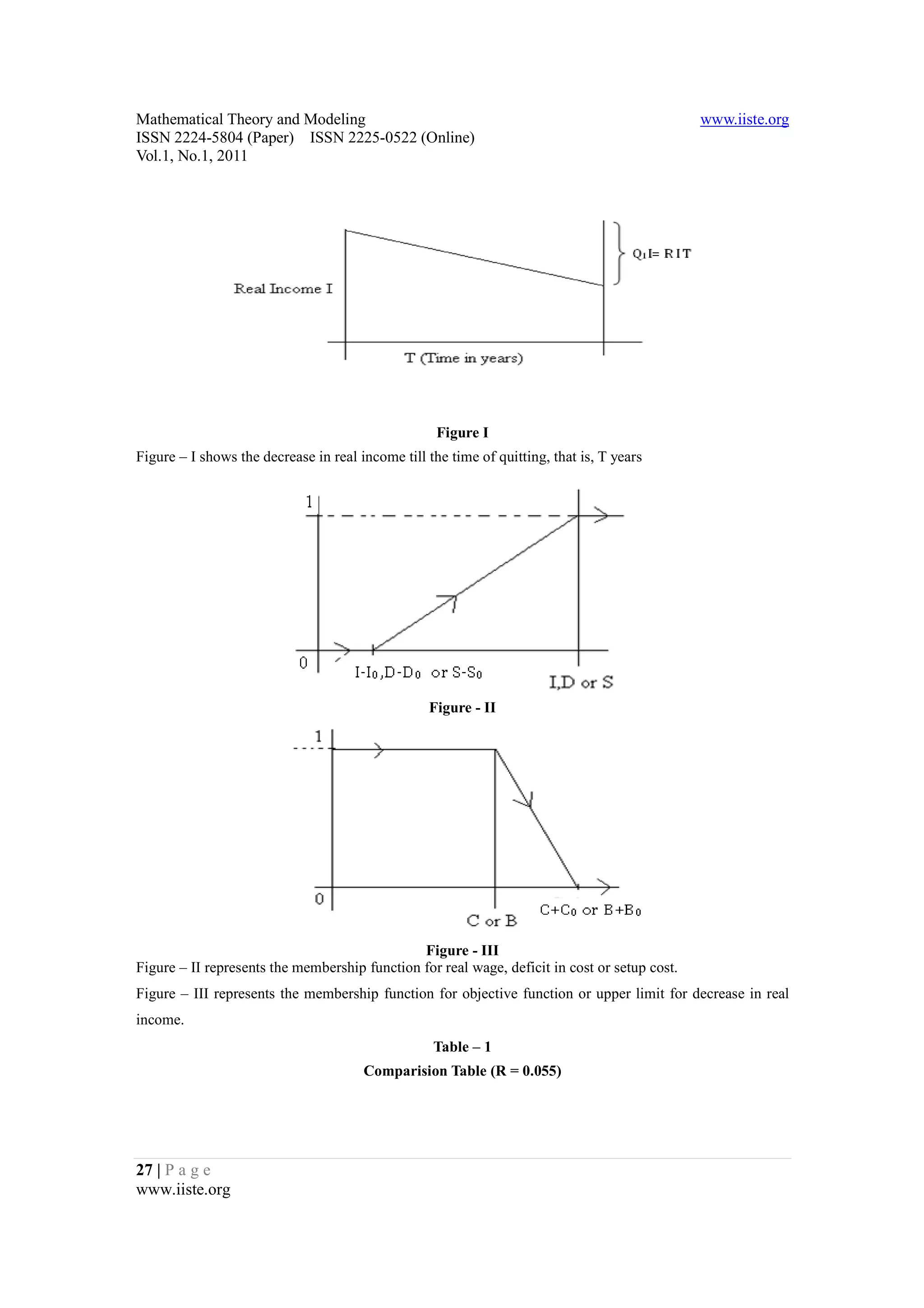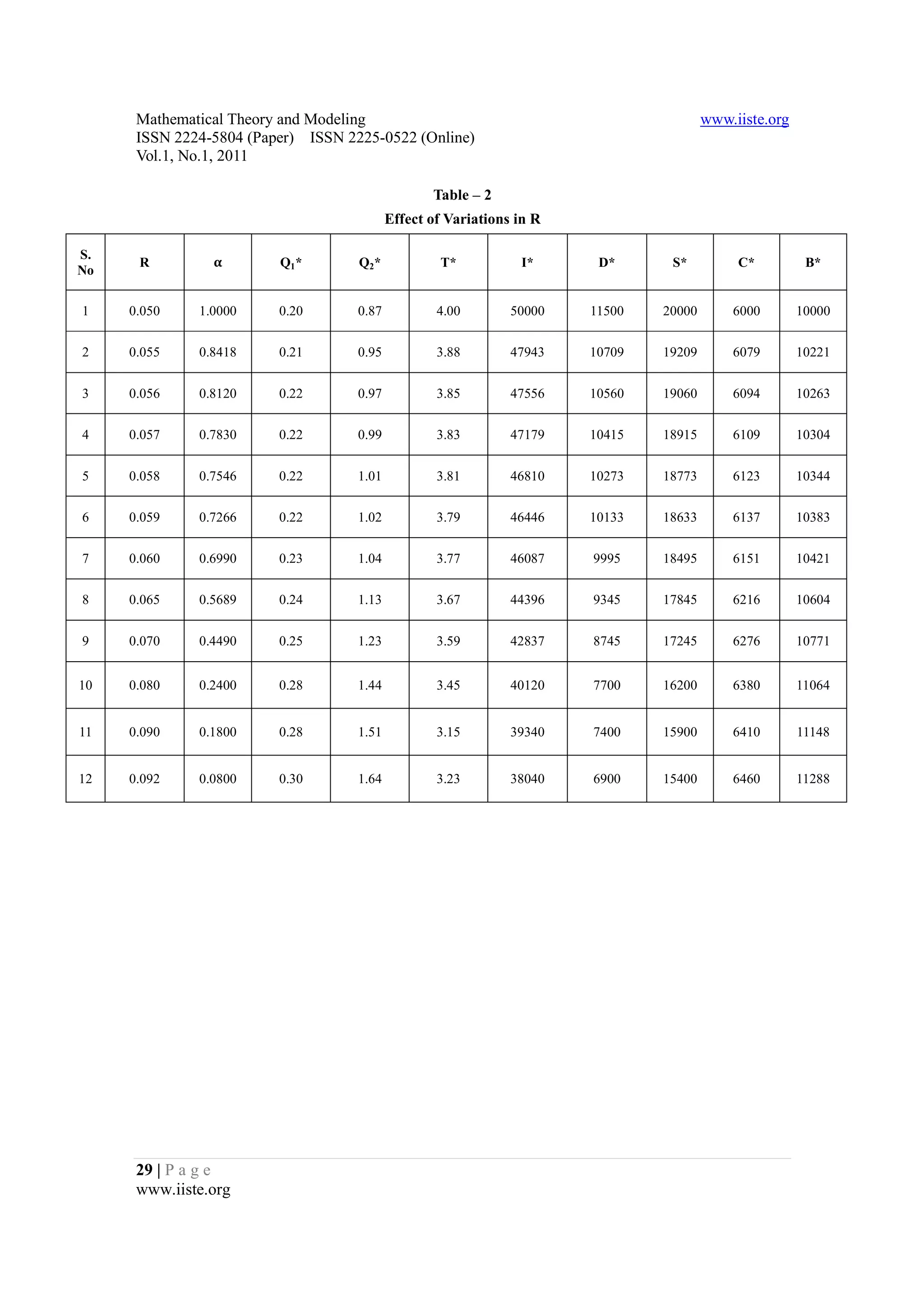This document presents a fuzzy inventory model to determine the optimal time for an employee to change jobs while minimizing costs. It introduces concepts like real wage, membership functions, and fuzzy nonlinear programming. The model considers costs of decreasing real income, moving to a new job, and income shortages. It uses Lagrange multipliers to solve the fuzzy nonlinear programming problem and compares the results to a crisp model. A numerical example is provided to illustrate the application to manpower planning.
![Mathematical Theory and Modeling www.iiste.org
ISSN 2224-5804 (Paper) ISSN 2225-0522 (Online)
Vol.1, No.1, 2011
Fuzzy Inventory Model with Shortages in Man Power Planning
Punniakrishnan.K1* Kadambavanam.K2
1. Associate Professor in Mathematics, Sri Vasavi College, Erode, Tamilnadu, India.
2. Associate Professor in Mathematics, Sri Vasavi College, Erode, Tamilnadu, India.
* E-mail of the corresponding author: punniakrishnan@gmail.com
Abstract
In this paper, an EOQ (Economical Order Quitting) model with shortages (of employees) can be studied.
The cost due to decrease in real wage and the cost involved in moving to a new job are considered, with a
constraint that, the decrease in the real income over a period of time is limited. In real life, these costs are
uncertain to a certain extent. This uncertainty has been discussed by utilizing the concept of fuzzy set
theory. Fuzzy non-linear programming technique using Lagrange multipliers is used to solve the problems
in this model. The application of this model in man power planning is illustrated by means of a numerical
example. The variations of the results with those of the crisp model have been compared. Further the
sensitivity analysis is also presented.
Keywords: Inventory, Economical Order Quitting, Real Wage, Fuzzy Sets, Man Power Planning,
Membership Function, Sensitivity Analysis.
1. Introduction
In the world, many researchers have worked on the EOQ model after the publication of classical lot-size
formula by Haris in 1915. At present, one of the most promising reliable fields of research is recognized as
fuzzy mathematical programming. Glenn.T.Wilson’s[4] square Root Rule for employment change has been
applied to develop an EOQ model in Man Power Planning to obtain the optimal time of quitting the present
job for an employee of an organization based on the condition that the salary increase in the new job is
equal to the decrease in the real income at the time of quitting[9].
In Inventory models we deal with costs that are crisp, that is, fixed and exact. But in realistic situations
these costs are varying over a certain extent of predetermined level. However these uncertainties are due to
fuzziness and in these cases the fuzzy set theory introduced by Zadeh[1] is applicable. In this paper an
attempt is made to obtain a fuzzy model for Wilson’s Paper[4] by adding an appropriate constraint. In 1995,
T.K.Roy and M.Maiti[10] presented an EOQ model with constraint in a fuzzy environment. The model is
solved by fuzzy non-linear programming (FNLP) method using Lagrange multipliers and illustrated with
numerical examples. The solution is compared with solution of the corresponding crisp problem. Also
sensitivity analysis is made on optimum increase in salary in the new job and on optimum quitting time of
the present job for variations in the rate of decrease in real wages following Dutta.D, J.R.Rao and
R.N.Tiwari[3].
As we know that the constant increase in the cost of living is always more than the increase in the salary of
an employee, which in turn causes a decrease in his real income. In this situation, it is quite common that an
employee thinks of quitting the present job and switching over to a new one. An EOQ model is analyzed
using fuzzy set theory, which gives the optimal time for an employee to quit, at a minimum cost.
2. Notations And Terminology
I – Initial real income of an employee in the first year of our discussion (Holding cost)
S – The cost of resetting in the new place (Setup cost)
D – The cost of deficiting at the time of quitting (Shortage cost)
19 | P a g e
www.iiste.org](https://image.slidesharecdn.com/fuzzyinventorymodelwithshortagesinmanpowerplanning-111203155042-phpapp01/75/Fuzzy-inventory-model-with-shortages-in-man-power-planning-1-2048.jpg)

![Mathematical Theory and Modeling www.iiste.org
ISSN 2224-5804 (Paper) ISSN 2225-0522 (Online)
Vol.1, No.1, 2011
functions which may be linear or non-linear. According to Bellman and Zadeh[1], Carlson and
Korhonen[2] and Trappey et.al[11] the above problem can be written as,
Max α
g ! (X, μ (α))≤ μC@ A (α)
Subject to:
A
@
X ≥ 0,
(3.3)
i = 0,1,2, … … … . m
where μ @ (X) and μC@ (X) are the membership functions of fuzzy objective and fuzzy constraints and D is
an additional variable wshich is known as aspiration level.
L(α, X, λ)= α- ∑!K λ! FGg ! (X, μ (α))H − GμC@ A (α)HJ
Therefore, the Lagrangian function is given by
A
@
where L! , (i=0,1,2,……..,m) are Lagrange multipliers.
(3.4)
According to the Kuhn-Tucker[8] necessary conditions, the optimal values
(X ∗ ,X ∗ ,……X ∗ ,λ ∗ ,λ ∗ ,……..λ ∗
,D ∗ )
should satisfy
= 0,
N
NOP
= 0,
N
NQ
λ! Gg! (X, μ (α)) − μC@ A (α)H=0
(3.5)
A
@
g ! (X, μ @
A (α)) − μC@ A (α) ≤ 0
λ! ≤ 0, i = 0,1,2, … … . m, j=1,2,3…….n
and
The Kuhn – Tucker sufficient conditions demand that the objective function (for maximization) and
constraints should be respectively concave and convex.
Solving equation (3.5), the optimal solution for the fuzzy non-linear programming problem is obtained.
4.EOQ Model where Fuzzy Goal, Costs are Represented by Linear Membership Functions
In a crisp EOQ Model, the problem is to choose the order level Q(>0) and Q=Q +Q which minimizes
the average total cost C(Q) per unit time. That is
MinC(Q)= I R T+ DR T + S R T
S S
S W
(4.1)
Q I≤B
Subject to:
Q >0
The fuzzy version of the square root rule for employment change model with one constraint is written as
follows:
Maximize α
μ A (α) R T+ μ (α) R T + μZ A (α) R T ≤ μ (α)
S S
Subject to:
A S W A
Q I ≤ μ[ (α)
(4.2)
A
Q > 0 , D ∈ [0,1]
where μ (x), μ (x), μZ (x), μ (x)and μ[ (X) are linear membership functions for real income, deficit in
cost, setup cost, objective function and upper bound for decrease in real wage respectively.
21 | P a g e
www.iiste.org](https://image.slidesharecdn.com/fuzzyinventorymodelwithshortagesinmanpowerplanning-111203155042-phpapp01/75/Fuzzy-inventory-model-with-shortages-in-man-power-planning-3-2048.jpg)
![Mathematical Theory and Modeling www.iiste.org
ISSN 2224-5804 (Paper) ISSN 2225-0522 (Online)
Vol.1, No.1, 2011
Assume that the linear membership functions are defined as follows:
0 bcd x < I − I
a I − x
μ (x) = 1−f g bcd I − I ≤ x ≤ I
` I
_ 1 bcd x > I
0 bcd x < D − D
a
D−x
μ (x) = 1 − f g bcd D − D ≤ x ≤ D
` D
_1 bcd x > D
0 bcd x < S − S
a
S − x
μZ (x) = 1−f g bcd S − S ≤ x ≤ S
` S
_ 1 bcd x > S
0 bcd x > C + C
a
x−C
μ (x) = 1 − f g bcd C ≤ x ≤ C + C
` C
_1 bcd x < C
0 bcd x > B + B
μ[ (x) = h 1 − R [ T bcd B ≤ x ≤ B + B
%A[
1 bcd x < B
------- (4.3)
Here I , D , S , C and B , are the maximal violations of the aspiration levels of I, D, S, C and B (or the
permissible ranges). From the nature of parameters defined, it is observed that the setup cost, deficit cost
and the real income are non-decreasing and the objective function and upper limit for decrease in real
μ A (α) = I − (1 − α)I ; μ (α) = D − (1 − α)D ;
income are non-increasing. Hence we have
A
μZ A (α) = S − (1 − α)S ; μ A (α) = C + (1 − α)C
μ[ (α) = B + (1 − α)B ------(4.4)
and
A
The Lagrangian equation takes the form as
L(α,Q ,Q , L , L ) = α – L k (I − (1 − α)I ) R T + (D − (1 − α)D ) R T + (S − (1 −
S S
S
+ S + S
α)S ) R T − (C + (1 − α)C )l − L [Q I − (B + (1 − α)B )]
W
+ S
--------- (4.5 )
By Kuhn-Tucker’s necessary conditions, we have
= 0 ⇒ 1− L I − L D − L S R T − L C − L B = 0
S S
N S W
NQ ( + S) ( + S) + S
--------(4.6)
= 0 ⇒ L k (I − (1 − α)I ) − (D − (1 − α)D ) − (S − (1 − α)S ) R Tl +
S
N ( S) S W
N ( + S )S ( + S )S ( + S )S
+
L I=0 --------
= 0 ⇒
N
(4.7)
N
L k (I − (1 − α)I ) − (D − (1 − α)D ) − (S − (1 − α)S ) R Tl + L I = 0
( S) S
S
W
( S) ( S) ( S)
+
+ S + S + S
-------- (4.8)
22 | P a g e
www.iiste.org](https://image.slidesharecdn.com/fuzzyinventorymodelwithshortagesinmanpowerplanning-111203155042-phpapp01/75/Fuzzy-inventory-model-with-shortages-in-man-power-planning-4-2048.jpg)
![Mathematical Theory and Modeling www.iiste.org
ISSN 2224-5804 (Paper) ISSN 2225-0522 (Online)
Vol.1, No.1, 2011
∂L 1 Q 1 Q
= 0 ⇒ (I − (1 − α)I ) p q + (D − (1 − α)D ) p q+
∂L 2 Q +Q 2 Q +Q
(S − (1 − α)S ) R T − (C + (1 − α)C ) = 0
W
+ S
∂L
------------- (4.9)
= 0 ⇒ IQ − (B + (1 − α)B ) = 0
∂L
⇒ IQ = (B + (1 − α)B ) -------------
(4.10)
Q =
([r( AQ∗ )[ )
Solving the equations, the expression for optimum quantity of salary rise is
∗
------------
(4.11)
Q =k lQ
A( AQ)
and the optimum Re-order level is
∗ ∗
A( AQ)
------------
where α∗ is a root of
(4.12)
(I − (1 − α)I )(B + (1 − α)B ) + (D − (1 − α)D )Q I + 2(S − (1 − α)S )RI − 2(C +
(1 − α)C )Q I = 0 [I − (1 − α)I ][B + (1 − α)B ] + [D − (1 − α)D ] Q I + 2[S − (1 − α)S ]RI −
2[C + (1 − α)C ][B + (1 − α)B ]I = 0
which is a cubic equation in (1 − α).
-------------(4.13)
Solving this equation we obtain α and hence Q ∗ , Q ∗
, I ∗ , D∗ , S ∗ , B ∗ , T ∗ , and C ∗ , the optimal values
which lie within the tolerance limit of fuzzy range.
When Q = 0, Equation (4.13) reduces to
Remark: 4.1.1
[I − (1 − α)I ][B + (1 − α)B ] + 2[S − (1 − α)S ] RI − 2[C + (1 − α)C ][B + (1 − α)B ]I = 0
(4.14)
Equation (4.14) is cubic equation in (1 − α) and the equation can be written as
which is the equation derived in [7]
IB (1 − α) − uB I − 2BB I − 2IC Bv(1 − α) − (2BB I − I B − 2RI S − 2IB C − 2II B)(1 −
α) − (IB + 2RI S − 2ICB) = 0 (4.15)
which is the equation derived in [6]
Example:
Let us assume that a person is possessed with the following fuzzy costs and goals
I = 50000, I = 13000 ; D = 11500, D = 5000 ;
S = 20000, S = 5000 ; B = 10000, B = 1400 ;
C=6000, C = 500 ;
Substituting these values in equation (4.13), we obtain the following optimal values α = 1 (the
R=0.05
Q = 0.2, T ∗ = 4, Q = 0.87 and hence I ∗ = 50000, S ∗ = 20000, D∗ = 11500, B ∗ = 10000,
maximum value)
∗ ∗
C ∗ = 6000 which are original values of I, S, D, B and C. These are the best optimal values. We can ever
23 | P a g e
www.iiste.org](https://image.slidesharecdn.com/fuzzyinventorymodelwithshortagesinmanpowerplanning-111203155042-phpapp01/75/Fuzzy-inventory-model-with-shortages-in-man-power-planning-5-2048.jpg)
![Mathematical Theory and Modeling www.iiste.org
ISSN 2224-5804 (Paper) ISSN 2225-0522 (Online)
Vol.1, No.1, 2011
get for this problem as the aspiration level α takes the maximum value (α = 1). From this result we
conclude that the person can leave this present job after 4 years provided that the increase in salary in the
new job should be atleast 20% and the Re-order level of salary (Re-order level of employees) for a certain
company should be atleast 87% of I, the initial income. With variations in R, the same problem can also be
solved.
Comparison of the crisp model with the fuzzy model for various combinations of extreme limits of I,
S, D, C and B for R=0.05 in the above example is given in the following table.
With R=0.055, it is found by the fuzzy model that the aspiration level α to be 0.8419 and the optimal
Analysis on Comparison Table – 1
cost being Rs. 6016 with the optimal time of quitting as 3.9 years with new salary rise being 21% and the
Re-order level in salary (Re-order level of employees)being 95%. But with different crisp parameter
These three expenditure values are greater than the fuzzy C ∗ value. Hence to get optimal solution for this
combinations, only three values (1,2 and 6) fall within the permissible expenditure range (6000-6500).
of parameters had to be worked out to get this optimal value C ∗ = 6016 , which is a cumbersome work,
problem by crisp model, the above eight different combinations are not sufficient, some more combinations
where as the fuzzy model simplifies the work of getting the optimal value. This is one of the advantages of
fuzzy applications in day today life problems.
5. Sensitivity Analysis
Consider the sensitivity analysis [6, 7] on EOQ’s and other costs with the variations in the tolerance
limit of total cost C which is shown in the following table.
Analysis on Comparison Table – 2
In table – 2, we study the effect of variations on R. As the cost of living index changes from place
to place, the rate of decrease in real income also varies from place to place. For the people dwelling in
I , D , S , C and B , we observe from the above table that as R increases, α decreases to zero. Further
different places with same I, D, S, C and B along with the same permissible variations in
Q ∗ and Q ∗ increases slightly. Also we observe that I ∗ , D∗ , S ∗ and T ∗ decreases and C ∗ and B ∗ increases
within the permissible range as R increases.
Tables similar to Table – 2 can also be constructed for variations in I , D , S , C and B
individually and the corresponding changes in α , Q ∗ , Q ∗ , T ∗ and other values can be studied.
6. Conclusion
In this paper, we have seen a real life inventory problem faced by an employee in connection with his
change of jobs, which could be solved easily by applying fuzzy inventory model. Sensitivity analysis is
presented. This model can be extended to inventory problems under several constraints also.
References
[1] Bellman R.E, Zadeh L.A., ( 1970) Decision making in a fuzzy environment, Management Sciences,
Volume 17, pp.141 – 164.
[2] Carlson,C., and Korhonen,P., (1986) A parametric approach to fuzzy linear programming, Fuzzy sets
and systems, Vol.20, pp 17-30.
[3] Dutta.D, J.R.Rao and R.N.Tiwari, (1993) Effect of tolerance in fuzzy linear fractional programming,
Fuzzy sets and systems, 55, pp 133-142.
[4] Glenn.T.Wilson, (1982) The square root rule for employment change, Operational Research Society,
33, pp 1041-1043.
[5] Hamdy A.Taha, (1988) Operations Research- An Introduction Sixth edition, prentice Hall of India
private limited, New Delhi.
24 | P a g e
www.iiste.org](https://image.slidesharecdn.com/fuzzyinventorymodelwithshortagesinmanpowerplanning-111203155042-phpapp01/75/Fuzzy-inventory-model-with-shortages-in-man-power-planning-6-2048.jpg)
![Mathematical Theory and Modeling www.iiste.org
ISSN 2224-5804 (Paper) ISSN 2225-0522 (Online)
Vol.1, No.1, 2011
[6] Kadambavanam.K and Punniakrishnan.K. (2011) “Fuzzy Inventory Model Allowing Shortages and
Storage Constraint” International Journal of Production Technology and Management Research to be
published.
[7] Kadambavanam.K and Punniakrishnan.K. (2011) “Inventory Model In a Fuzzy Environment With
Exponential Membership Cost Functions” Ciit International Journals to be published.
[8] Kuhn.H.W and Tucker.A.W. (1951) Non-linear programming. In.J.Neyman (ed), proceedings second
Berkely symposium on mathematical statistics and probability, University of california pracil, pp.481-498.
[9] Rajalakshmi Rajagopal and M.Jeeva, (2001) Fuzzy Inventory Model in Man Power Planning,
proceedings of the National conference on mathematical and computational models, December 27-28,PSG
college of Technology, Coimbatore, India.
[10] Roy.T.K. and Maiti.M., (1995) A fuzzy inventory model with constraint. Opsearch, Volume 32, No.4,
pp.287-298.
[11] Trappey, J.F.C.,Liu, C.R. and Chang, T.C., (1988) Fuzzy non-linear programming. Theory and
applications in manufacturing, Int. J. Production Research, Vol 26, No.5, 975-985.
[12] Zimmermann.H.J., (1996) Fuzzy set theory and its applications. Allied publishers Limited, New Delhi
in association with Kluwar Academic publishers 2nd Revised Edition, Boston.
25 | P a g e
www.iiste.org](https://image.slidesharecdn.com/fuzzyinventorymodelwithshortagesinmanpowerplanning-111203155042-phpapp01/75/Fuzzy-inventory-model-with-shortages-in-man-power-planning-7-2048.jpg)



